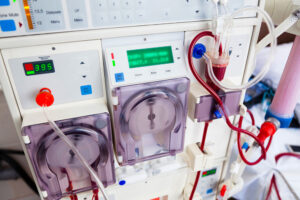 At Brigham and Women’s Hospital, nephrologists have observed an increased risk of acute kidney injury (AKI) in COVID-19 patients. Within the intensive care units (ICUs) at the Brigham, about 15 to 20 percent of COVID-19 patients have developed AKI. In some hospitals, the incidence of AKI has been reported to be as high as 25 percent.
At Brigham and Women’s Hospital, nephrologists have observed an increased risk of acute kidney injury (AKI) in COVID-19 patients. Within the intensive care units (ICUs) at the Brigham, about 15 to 20 percent of COVID-19 patients have developed AKI. In some hospitals, the incidence of AKI has been reported to be as high as 25 percent.
“We know that patients infected with COVID-19 suffer from renal involvement, because a high percentage of them develop proteinuria and hematuria,” says David Bruce Mount, MD, clinical chief of the Brigham’s Renal Division. “AKI is a frequent concomitant of acute respiratory distress syndrome (ARDS) in COVID-19, but it’s hard to clearly state the incidence of AKI at this point, in the absence of large-scale studies.”
Risk Factors for AKI in COVID-19
Patients with kidney disease or diabetes and hypertension are at a higher risk of developing AKI and requiring renal replacement therapy. While there’s an increase in AKI in COVID-19 patients, the disease can affects patients’ kidneys differently.
“In some patients with COVID-19, the kidneys shut down early and require continuous renal replacement therapy (CRRT),” says Peter Gregor Czarnecki, MD, clinical director of the critical care nephrology section at the Brigham. “In other patients, the kidneys are quite stressed but they’re working adequately with medical support.”
Abnormal Coagulation May Drive AKI in COVID-19 Patients
Several mechanisms have been proposed to explain the increased risk of AKI in patients with COVID-19. Some histopathologic studies in autopsies show that SARS-CoV-2 may directly infect renal tubular cells. To learn more, Dr. Czarnecki and others are planning to study specimens from native kidney biopsies from infected patients.
While direct infection may contribute to the development of AKI, it’s likely that renal dysfunction is also affected by abnormal coagulation in COVID-19 patients. The kidneys are vulnerable to changes in clotting, especially the endothelial cells in small vessels.
“The massive immune activation seems to trigger hyper-coagulability in COVID-19 patients,” says Dr. Mount. “This pro-coagulant state can produce thrombotic microangiopathy in many organ systems, including the kidneys.”
Treating AKI in COVID-19 Patients
In the Brigham ICUs, COVID-19 patients with AKI, especially those with hemodynamic instability, are treated with CRRT. Indications for CRRT include: volume overload, hyperkalemia, metabolic acidosis or uremic manifestations (e.g., uremic encephalopathy). Many AKI patients are also receiving one to three vasopressor medications.
“As nephrologists and intensivists, we know how to respond to the consequences of AKI in COVID-19 patients,” says Dr. Czarnecki. “But we still need to learn more about the specific footprint that COVID-19 has on the kidneys, so we can understand how to manage this disease proactively.”
After leaving the ICU, some patients who experienced AKI still require dialysis. The minority of patients who need dialysis after discharge are transitioned to an outpatient hemodialysis facility. They can be treated if they’re negative for COVID-19 and agree to repeat testing. Patients who have long-term consequences from AKI, including chronic kidney disease, require close monitoring and long-term nephrology care.
Challenges of Delivering Dialysis During COVID-19
In the early stages of the pandemic, the Brigham had to overcome a number of logistical challenges involving the delivery of renal therapies.
To manage the increased demand for dialysis, clinical teams doubled the number of continuous veno-venous hemofiltration (CVVH) machines in ICUs. To extend the life of CVVH cartridges, the Brigham also participated in a study to develop a new anti-coagulation therapy with heparin.
“It’s still early in our understanding of COVID-19,” says Dr. Czarnecki. “This disease is an entirely new problem and the medical and scientific community is still assessing the spectrum of its manifestations. But we learn new ways to manage COVID-19 every day.”